A Fitting Transporteur
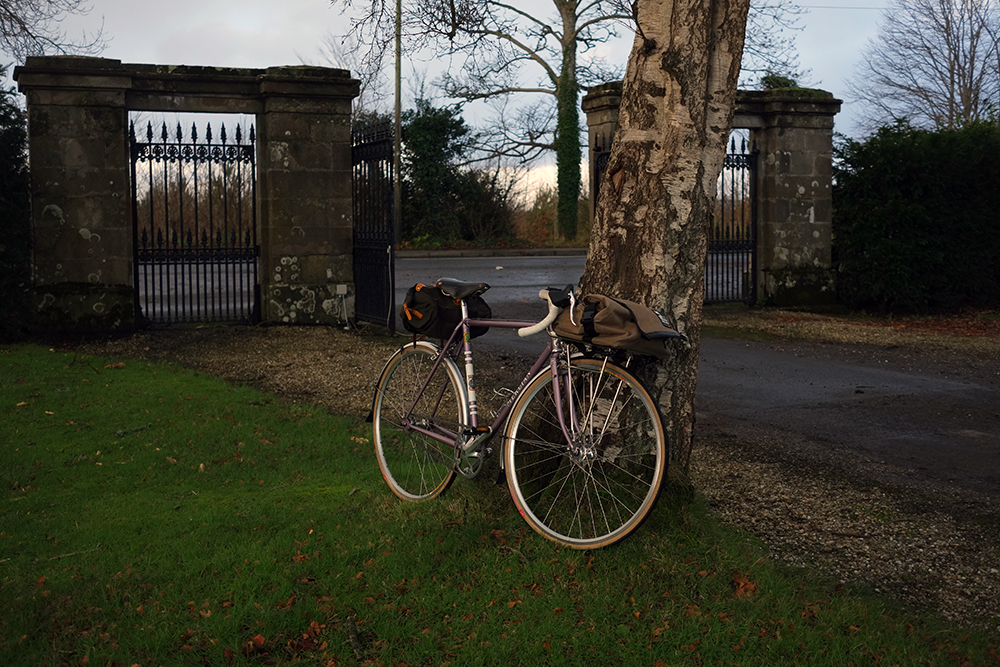
Want to know the surest way to improve the weather? Buy your bicycle mudguards! As I pedaled home, my new Zefals gleaming in the unfamiliar sunlight, I could almost hear the dry roads laughing at my formerly sleek and minimalist fixed gear steed, now looking more like an overburdened pack mule.
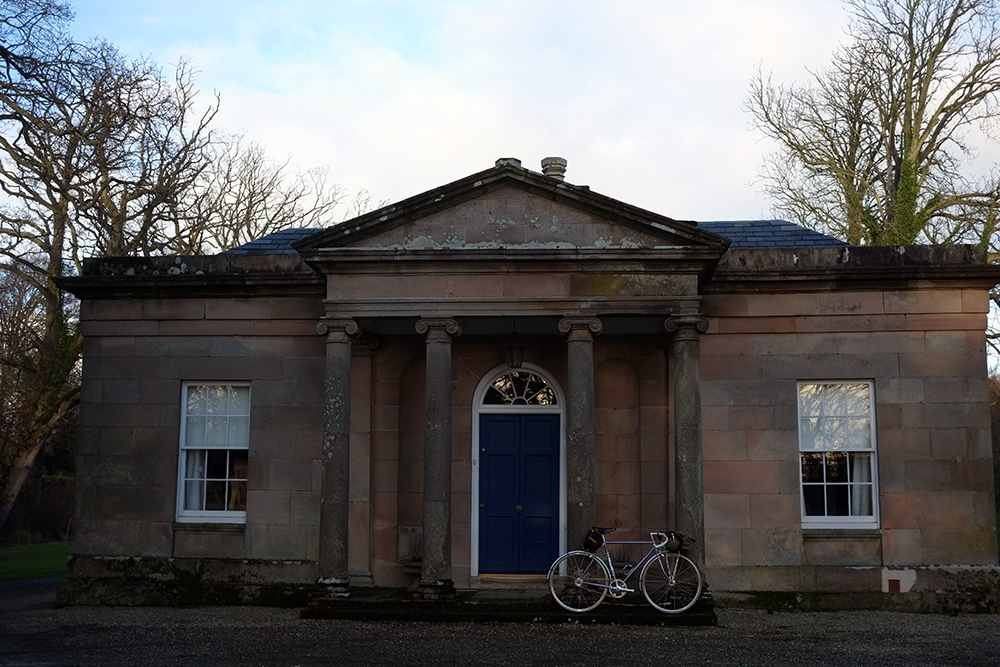
Earlier I have written about a Dawes touring frame that fell into my hands, with exaggerated "long and low" dimensions. We set it up as a "transporteur," then passed it around so that a few riders could try it on for size. When my turn came to use it, it was clear that the bicycle was too long for me. It was also clear, however, that I loved the setup in itself, having found the drop bars + porteur rack + mudguards + flat pedals combo very handy for commuting this relentlessly windy season. So while I didn't keep the Dawes, I decided to reconfigure one of my own bicycles with an identical setup.
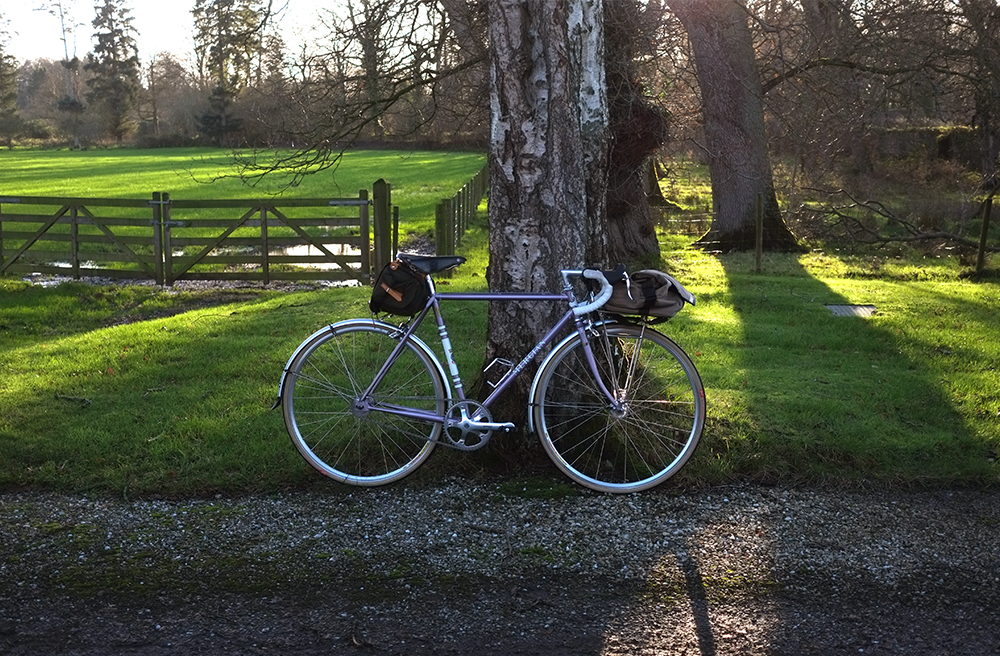
For the job I decided to use my Mercian single speed. On the surface, it may seem that my DIY 650B bicycle - low trail and already fitted with lights, mudguards, and small front rack - would have been a more obvious candidate. But I like to keep that bike sporty and light for hilly mixed terrain adventures, and would rather not overwhelm it with a pizza-sized rack. That, plus I used super-thinwall blades for the fork, which are not rated for a heavy front load. The Mercian, on the other hand, has continued to go under-utilised this year. And so finally, I think I am ready to admit that I am just not able to ride a fixed gear bicycle in the same manner (i.e. as aggressively and over the same terrain) as I do a geared roadbike. Therefore, to keep the Mercian set up as a minimalist, lightweight, recreational-use roadbike began to seem pointless. Better to experiment with turning it into a "transporteur!" The Reynolds 631 frame and fork should be hardy enough to carry some weight in the front and rear, I figured. The single speed setup would be sufficient for the elevation gain I encounter during commutes. And it even has eyelets for mudguards. My only concern was, how it would handle with lots of weight in the front. Well, there was only one way to find out.

In moving the Pelago commuter rack (review soon) from the Dawes, I quickly realised it was not a straightforward swap. The Mercian's wheels are a bit smaller, so the rack as shown sits slightly too high and is secured at the rear with a cord rather than properly with a bracket (which will need to be adjusted). Mainly I
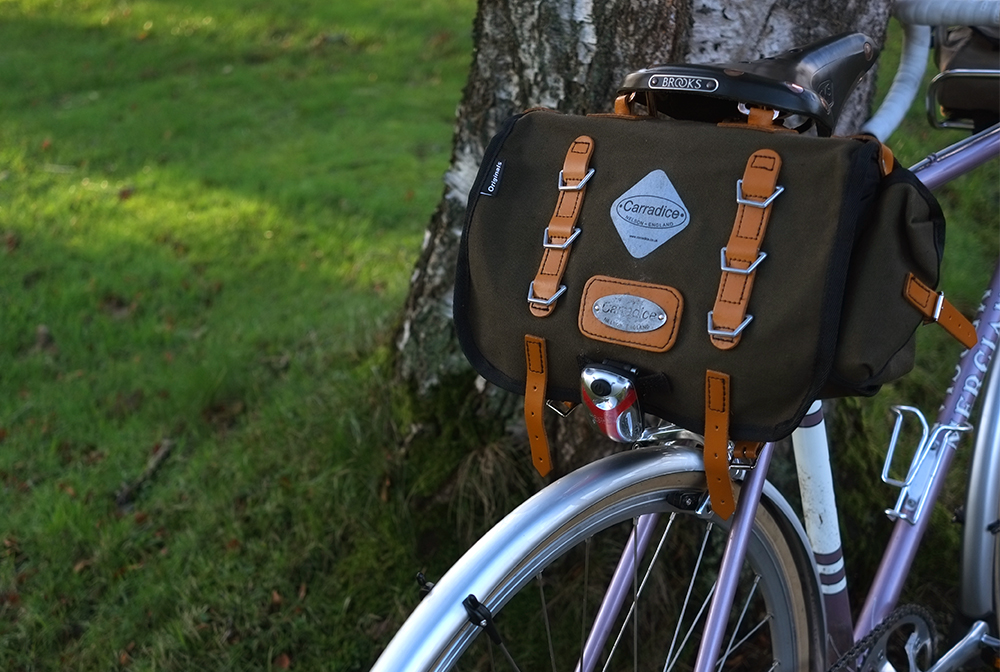
In the rear, I fitted my Carradice Barley for extra storage.
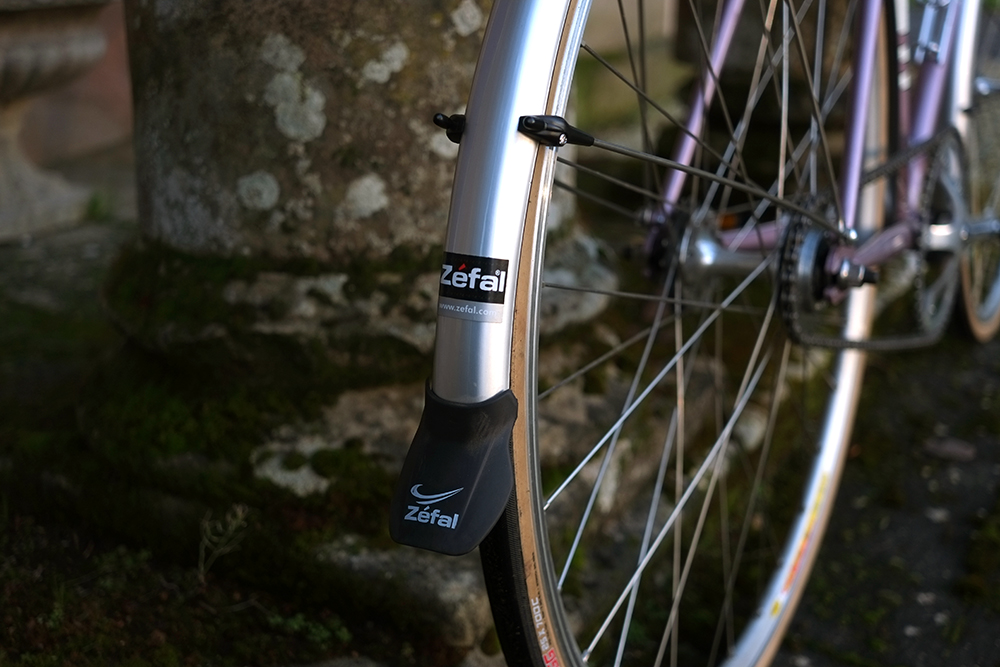
Then headed to my local bike shop, where they happened to have a pair of lovely lightweight Zefals lounging about.
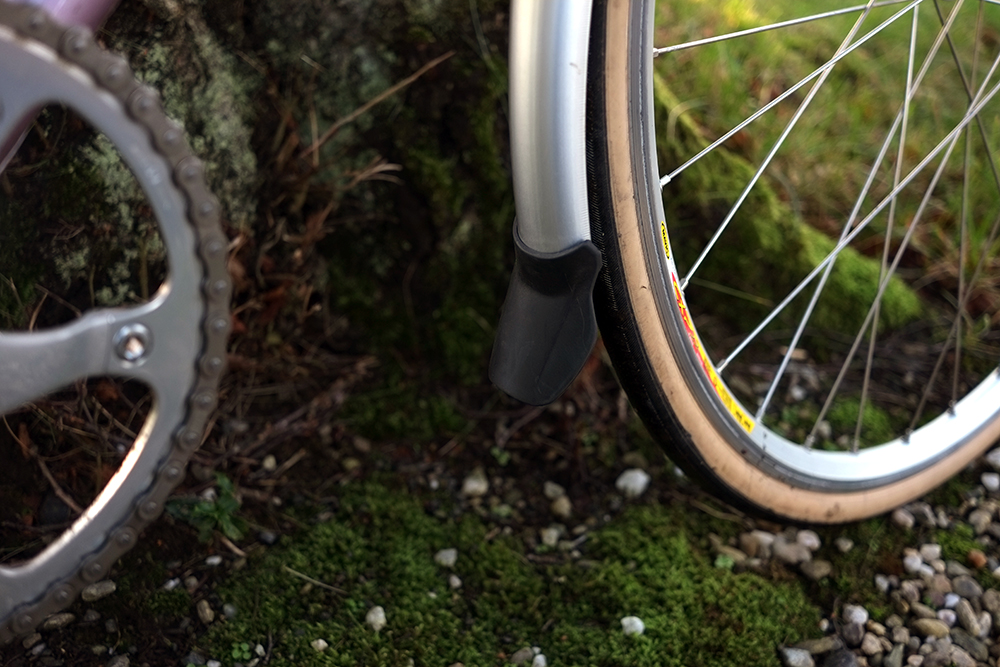 What I like about these mudguards is that, aside from providing good coverage, they are subtle and unobtrusive - neither oversportifying nor overFrenchifying the bike. That, and the adorable tiny mudflaps.
What I like about these mudguards is that, aside from providing good coverage, they are subtle and unobtrusive - neither oversportifying nor overFrenchifying the bike. That, and the adorable tiny mudflaps.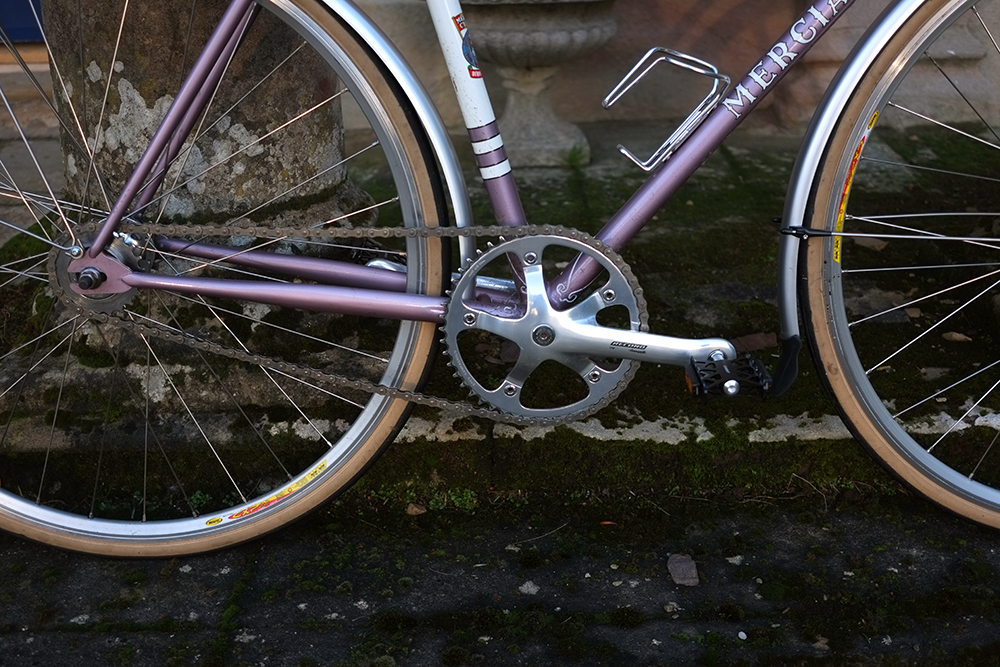
I also "flip-flopped" the bike's rear wheel from fixed to free mode, not wanting to make things overly difficult for myself while testing the front load setup. If I like it, and once I get used to it, I will change it back to fixed.
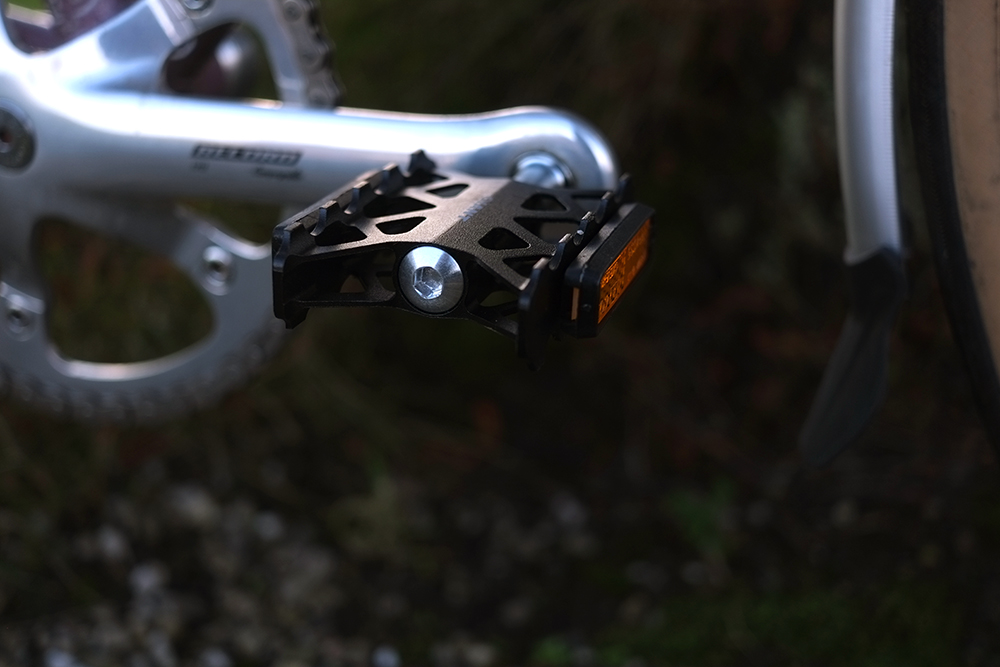
Finally, after testing this setup once with the bicycle's usual clipless pedals, I decided to switch to flat ones, so that I could ride in ordinary shoes.

The overall look is, I think, quite nice and not overly clunky. But more importantly, I knew from the first ride this setup is a keeper. While stuffing the front bag full of groceries does make the bike noticeably more flexy, as far as handling the utility-sized front load feels just fine over the Mercian's mid-trail front end. I am aware of its presence, and it does dull down, or at least "de-sportify" the handling somewhat. But the front end remains stable on turns, and neither "wanders" nor threatens to topple over when I stand out of the saddle on hills. So, as far as safety, and for the purpose of commuting, it is absolutely fine in my book. The only problem really is the usual wheel flop, when the bicycle is being "walked" or parked; the front end wants to turn in on itself and, in the absence of one of those springs, I just have to watch it doesn't buckle when, say, leaned against a pole.
On a day like today it was hard to believe that the past months have made transportation cycling hell with constant gale-force winds and lashing rain. I hope this bicycle - its sport geometry and aggressive road position now supplemented with the ability to carry work equipment, and provisions for riding it in ordinary clothing, will help me cope with these conditions better. The Dawes, while I had it, did a splendid job. But the Mercian's size and geo make for a much better fit. When I bought this bike 4 years ago, I had deliberately chose it to be versatile. My idea was to ride it as a minimalist, sporty fixed gear "while young," then fit it with racks and mudguards, possibly even a geared hub, in old age. Well, it looks like this came a bit sooner than anticipated - but not a moment too soon nonetheless. For no sooner than I snapped these photos, the sky turned black and the wind picked up again, making for an epic push home along exposed country roads on a happy, befendered bicycle.

Those fenders, and the bags, look good on the Mercian. After I read your post, I did a quick ebay search to see if they still make Bluemels, which I think would look cool on that bike. A couple of NOS pairs were priced at around $200. Ouch.
ReplyDeleteWithin enthusiast circles, you can often get Bluebells for much less, or "for free" in trade. But this bike has no other vintage parts on it, and honestly I just wanted something simple to instal and practical. I think the Zefals look "right" with the other components, and they certainly do the job. Will report on durability in due course.
DeleteBluemels. Autocorrect!
DeleteI heard you have to go to Texas to find Bluebells fenders.
DeleteBluemels would be lovely on that Mercian. However....
DeleteWhen Bluemels were conceived nearly every bicycle was sold with OEM steel fenders. Celluloid fenders were a sure sign of a very sporting rider. Bluemels sold Lightweight fenders, Airweight fenders and No-Weight fenders. Buyers of No-Weight fenders did not expect much in the way of longevity. When you could get a replacement fender at your LBS for a few bob it did not much matter. Today they are best for display bikes.
My own main road bike was built in 1950. Excepting tires, pads, cables, and rear spokes it is all 1950s parts and all of them very serviceable. When it gets Bluemels it goes on the wall.
The cute option for those who want something special and plan to use their bike is painted-to-match. Always looks great. Very few do it so your bike stands out. Routinely mistaken for OEM.
Personally I don't know much about the Zefal fenders. The US market has SKS and PlanetBike fenders that work very well and last long enough paint could make sense.
I have used Zefal pumps, water bottles, cages and mudguards since moving here and am impressed with the durability/weight/price ratio. SKS would be the nearest thing as far as the mudguards, but for skinny tyres I prefer the Zefals.
Delete(clicked too soon)
DeleteAs for Bluemels, I admire them on other's bikes but for some reason have never felt the urge to install them on mine. In fact I have owned 2 sets in the past that I have ended up trading for other parts.
I'm glad to see you were able to put an ILE porteur bag to profitable use. I am a huge bag junkie, with messenger bags/backpacks and bike-oriented bags of many types and from lots of bagmakers. The first time I mounted an ILE porteur bag (on a VO porteur rack-- a perfect fit!), it was one of those semi-embarrassing moments when I found myself more or less fondling the snaps and the folds and the pockets, all the while oooohhing and aaaahhing at how I couldn't think of a single thing I would change about the design. Truly one of those rare bits of bike goodies that just can't be improved upon. I do hope you have the opportunity to add pics that show the bag fully loaded with groceries (or flowers or knitting or camera gear-- we know how you are!), as it is very surprisingly versatile in terms of volume.
ReplyDeleteI am very difficult to please when it comes to these types of bags and prefer ultra-simple designs without too much folding and tucking and buckling involved. However the ILE bag is pretty excellent, in particular in its compatibility with drop bars. Review is next in the queue.
DeleteWith its color scheme and 'come look at me' lug work I've never thought of this bike as sleek and minimalist. Also, in its current state, it's far from a overburdened pack mule. It's just a bike modified to be relevant and useful.
ReplyDeletePared down would probably be a better term.
DeleteBut I suspect classic lightweights enthusiasts would recoil at the sight of a Mercian with a loaded front carrier setup.
Would you mind sharing the make/model of the flat pedals you used? (Beautiful ride!)
ReplyDeleteThey are Giant Ultra Light (that's the model name) pedals. The grip in the wet is pretty good.
DeleteBeautiful setup here. The first paragraph got me smiling because the same happened to me. I had just finished throwing together a decrepit '66 Schwinn Varsity frankenbike with single speed coaster, etc. meant to be a junker so I didn't put fenders on. First day I rode it: unexpected downpour. It was my ONLY bike with no fenders and I was stranded with it. Had to stick a piece of cardboard between the seat rails to keep my bum dry. Afterward, I said "never again" and added a pair of fenders from another parted-out schwinn. Has not rained since.
ReplyDeleteJust think of it as a service you have performed. Now all these people can enjoy lovely weather thanks to you fitting fenders!
DeleteThanks for your posts on porteur bags. I've been redoing my Schwinn (http://gordoncoale.blogspot.com/2015/11/my-fixed-gear-schwinn-typhoon-mark-ii.html) and a porteur rack and bag (Chrome Industries) are on the way. Riding a bike is fun but riding a useful bike is even more fun.
ReplyDeleteThat is interesting. Did you keep the handlebar height as-is in the current photos? How does the handling feel?
DeleteGordon Coale - you Schwinn looks great - I love the handlebars - what a fun and comfortable bike to ride - reminds me of my brothers paper round bike, those bikes had style :)
DeleteThe parts are still trickling in to add the porteur rack. New fork for cantilever brakes and SKS fenders. Should have it all together in a week. My new handlebar height is pretty much the same. Will report back when it's all together.
DeleteWhat are you going to do for that leather saddle in the rain? And the Carradice bag-plastic bag inside? I have a similar setup-single speed, Carradice bag, Brooks B17-and I avoid taking it out in the wet.
ReplyDeleteWalter
I put a cover, or plastic bag, over the saddle and otherwise don't worry about it too much. This is one of the older Brooks models whether the leather is pretty tough and takes ages to break in, so a bit of wet actually does it good.
DeleteThe Carradice bag, while not 100% waterproof holds out pretty well actually, and the older it is the more waterproof it seems to get (no doubt because the oil from my grimy hands touching it helps!). So yes, the contents are always inside a separate bag, but in fairness the inside of the Carradice itself is very seldom wet, even in severe steady rain. Keep in mind though that my commute is under an hour in duration. If I were, say, touring with it, it would be a different story.
What a lovely bicycle! I really enjoy a good utility setup with classic lines, more so than any minimalist things.
ReplyDeleteIn lieu front wheel stabilizer, you can also use a spare strap around the front wheel and down tube to keep your front wheel under control while parked.
With a different bike, I did that once then forgot to take it off - with a near disastrous outcome. Not recommended for the scatterbrained!
DeleteLovely!
ReplyDeleteFunny, I just reinstalled the Fenders on my Drakkar several days ago, then proceeded to almost immediately got them all jammed up with mud when a footpath turned out to be unexpectedly Muddy!
That's my Luck lately!
Enjoy!
-masmojo
Used to happen to me on my formerly-owned Rawland all the time. Thankfully I have (a bit!) more clearance on my DIY 650B bike.
DeleteI've got a junker with plastic fenders that does winter duty and I find that spraying WD-40 or some other thin oil on the underside of the fender seems to help alleviate the problem of wet snow getting packed inside. Not sure if it would work for mud too. Not recommended for a bike that is parked indoors ;) The petroleum products are probably no good to the plastic either so maybe save this treatment for the less-valuable fenders.
DeleteThere's an interesting idea.
DeleteCar wax works really well under fenders but you have to remove the wheels to put it on right. I know people who spray the undersides of their motorbike fenders with silicone spray or baking spray to keep mud and ice from building up off road. Not great for bikes with rim brakes though...
DeleteI like your idea more. Seems less messy and drippy. And yeah, ideally you'd remove the wheels to apply any "non-stick" layer because spray getting on the tires and brakes would be dangerous.
DeleteWhere and how do you store your dripping bikes and equipment? Also wonder if you've noticed any extra maintenance issues with all the wet.
ReplyDeleteI lube the chain much more often when it's raining like this, but otherwise no extra maintenance issues. The dripping bikes get stored in the hallway and the dripping clothes on hooks, then on the radiators.
DeleteOh, wow! My miles in the rain make me frustrated with maintenance. I never noticed it with a car but now that I'm totally bicycle it's surprising.
DeleteWhat sorts of problems are you having, and do you leave the bike outdoors for prolonged periods of time?
DeleteI've exposed cables, both gear and brake, unsealed bearing surfaces, and even the springs and bushings on my brakes make unpleasant sounds after prolonged wet and need attention. Muddy puddles accumulate in my hallway as the bike dries out and drips reminding me of what the bike is collecting on every ride. I park it my house but it must sit parked outside for hours at a time during the day.
Delete"Where and how do you store..." This question hints at something I've wondered about: the (very) many bicycles that Velouria rides! I myself have some 9 bicycles: from a 35 year old steel racing bike (bought new by myself), two other racing bikes, 1 mountain, 2 folding, an unsuspended mtn. bike converted with an xtracycle kit to a long bike, and 2 city-style 'guest bikes' for visitors. Storing these bikes a challenge, only recently fortunate to have ample garage space. Would love to know V's methods of storage. After years of working in bike shops I favor hanging from hooks against walls or from ceiling joists.
DeleteAlso, how do you like those Clement LGG tires? Just installed a pair onto a Medici in preparation for the California Eroica coming up in April. Their profile at 28C fits fine in the racing frame and fork and look good.
DeleteAt first I thought is was sort of a shame to put flat pedals and a bunch of luggage on that bike but the more I think about it the more it appeals. Bikes set up like that are so practical and good natured, I wonder that more people don't spend more time and money turning them into "Art Projects" instead of building $5,000 "Fast" bikes that just get obsolete in a year or two and trashed from being hammered all over Hell and back.
ReplyDeleteI'm trying to find a nice old Brit frame in 6ocm to replace my current old 531Puch which is just a bit too small to ride far and long as a fixedgear. If I don't find one soon I might do something dumb like rob a liqueur store to finance a sweet Mercian like yours. I've almost done that a couple of times after seeing yours and a few others. I'd want mudguards and now probably mounts on the fork after hearing how well yours handles a load. I'm surprised you don't have a tame welder ready to fab you up some sort of nice modified bracket so you wouldn't have to lash that rack on with a dog collar. If you still lived over here you could have knit someone a sofa or something to do it for you.
Whatever I end up with I'm going to run big fat CX tubulars and have a second wheel with a 3spd. Sturmy for when I want to get a bit farther from home, and then I'm going to go out in the rain and pretend I'm in Ireland.
Spindizzy
bicycle snap!
ReplyDeletehttp://morag.notdot.org/photos/mercian2.jpg
I've been trying to find an appropriate rack for my Mercian too, my normal utility and load luging bike is much burlier and equipped front and rear with low riders and flat-top racks and also great for towing the trailer but sometimes it's nice to use something a bit lighter and more fun when you don't have a lot to carry.
Hey, nice colour!
DeleteWelcome to the world of bicycles. This is nothing new. This is where you started and where you'll end. Tinkering. To say that this is a keeper makes me laugh. Evidence suggests that this, too, will continue to evolve.
ReplyDeleteThere are a few inviolable rules; number 3 is that fixed gears and weighty bike luggage do not mix. You can carry weight on your person (messenger bag) but not on the bike. When heavy loads are carried by the bike the fixed gear makes it difficult for the rider to adjust the balance relationship between rider and machine. Yes, it is possible to carry a heavy load on a fixed, but it is uncomfortable and sometimes dangerous. In your case, in search for simplicity for a practical winter bike, try using a Sturmey Archer 2 speed automatic with a 39x24 setup. This gives you a 43 inch direct drive gear for hills and a 61 inch overdrive gear for flats. It is elegant, robust and practical. You can used the SA hub with drop bars provided your position is not too extreme.
ReplyDeleteThe Fossil
Based on personal experience I feel the same, though I know quite a few fixed gear riders who would disagree (and I mean 'old timers,' not kids portaging 6 packs on their fixies).
DeleteIn the long run the fate of this bike will almost certainly involve an SA hub and I will look into the setup you mention.
If it's 2016 I have been riding fixed for 50 years. Does that qualify me as an oldtimer?
DeleteI violated inviolable rule #3 this morning. I had 50 pounds of groceries and hardware on my fixed gear DL-1. Entirely uneventful, as always.
Workcycles (Henry in A'dam) still has some of the heavy cycle trucks with fixed gear as standard. Henry will build you most anything but I'd bet if you wanted those big bikes with a freewheel he'd have some pushback.
Before WWII most cycletrucks and heavy delivery bikes were fixed just because it was cheaper than a freewheel. Instant braking by counterpedalling is also a big plus on any utility bike.
I see the freewheel on the Mercian is 21 or 22T. Use a fixed cog that size and you'll have no problem. If you go Sturmey the best option would be a TF.
My fixed cog is slightly smaller, because the bike needs to be geared higher when fixed. My plan was to re-fliplop the hub once I get used to the weight, so that I try it both ways and decide which I prefer. Some day this week when I remember to do it, the bike shall be fixed again.
DeleteMost puzzling. It is my experience (50 years of it) that a fixed which is even marginally overgeared for the task at hand is difficult to control and quite frustrating to ride. Nearly all the time fitting a lower gear will solve the problem or minimize the problem.
DeleteBicycles are inanimate and don't actually need anything. Riders want their bikes to do this or that. How you would know that your bike is going to respond this way or that way to a change of gears is beyond me, seeing as how you've been on one and only one gear for quite a long time. If I have been off fixed for any amount of time, or try riding fixed in a venue away from home, I expect to try a gear or three before finding the one that will suit me. Fixed riding is massively responsive to small incremental changes in gear ratio.
Oh it's not overheard for the task; it's a very reasonable 68 gear inches. As is, I can climb any hill encountered during my commutes. Any lower and I couldn't comfortably ride the descents.
DeleteThe freewheel side is geared a tad lower, only because when fixed the bike is actually easier to push uphill.
You must be very strong. Even when I was your age and racing regularly I could not have managed the terrain you describe on a fixed gear so large. Presently a 49x19 would not get get me up a sustained climb of more than 2% or perhaps 3%. A 5% grade would have me out of momentum and walking in a few yards. Similarly if I tried to manhandle a 49x19 down a 5% grade it would be all done with brake calipers, my legs could not hold back so large a gear.
DeleteYou are not getting much performance out of all that strength. Christmas Morning I spent in a pickup group of ten riders spinning along on 48x19. This was in dead flat Florida. Slight headwind. I was told that my pulls were at about 28mph. This from an elderly and somewhat stout man who was not at all stressed by such riding. It was a pleasure. Riding fixed is quite different when you know what you are doing.
The first forty years I rode fixed every single rider I saw trying the fixed wheel easily made 140-150 rpm the first time down any hill. And then they developed leg speed. These past ten years I am seen at 140rpm and other riders respond with wonderment. They wish to believe I am some physiological freak, a severely abnormal case. If you could only get a little leg speed trouble on the descent would be gone. I could tell you how to get leg speed but I don't think you would like it.
I had a very strong friend. He lived at the foot of a 600 foot climb that did a near constant 8% grade for a mile and a half. When the weather was too cold or wet for a long ride he did repeats on that hill using a fixed gear of 50x20 or 67-1/2". Needless to say he had huge legs. It took his friends twenty years to convince him that he should try lower gears. Once he geared down he lost 20 pounds, got fast, and won every race he entered. He did get weaker when he got fast. He needed a 42x21 to get up his training hill. Twenty years of lost opportunity with all his friends continuously telling him the same thing.
I am much stronger than I used to be a couple of years ago, but still not "very strong." It's just that it is easier for me to go uphill in an all-arounder gear than downhill in a too-low gear.
DeleteMy experience with all this is only a fraction of yours. But to be clear, I *have* experimented with gearing (as opposed to was given a bike with a random gearing combination and stuck with it unquestioningly), so the gears currently on this bike are a result of trial/error/adjustment. Keep in mind also that my bike is perhaps half the weight of your DL1, which certainly affects what the gear feels like to push. In any event: For me personally, on local terrain, too low in fixed is more difficult to handle than too high. With my current gearing I spin on flats, work a bit uphill, and can manage downhill without breaking my legs or having a heart attack. Works for me.
For clarity, I do not ride my DL-1 at 28mph. That bike has major aero drag. If anyone can ride those beasts at that speed I'm not certain, I certainly can't. The Christmas ride bike was a 1958 Rivets weighing 20 pounds. If I weighed the modern way with no pedals, clips, straps, bottle cage I might claim an 18 pound bike. In the years when my daily work entailed hauling 50-100 pounds of tools I used ordinary dropbar sport bikes fitted with fixed wheel. Safest and simplest way to get the job done.
DeleteI've reviewed some maps and verified some of the familiar grades around home. Accuracy matters between 2 and 3%. I can get up a 2 with your gearing. I would not want to do it for commuting or with a load. Even when I was young and much lighter a 3% grade with your gears would be an achievement, not a daily ride. Looking at the (wonderful) photos you post of your local roads I am very certain I could not now and never could have done those grades on 49x19. Not a chance. You are indeed quite strong. On a full Eddy Merckx non-aero road bike I could once do 40k in 58 minutes. I could not do your hills on your gear. With your strength you would be very much faster if only you had any technique at all. The first step in acquiring technique is to not sabotage the process by creating impossible tasks.
Looking at the photos of the Mercian again I note that your saddle is positioned directly above the axis of the BB. That would make your bike nervous handling on any descent. Enough so that learning to sit calmly and spin out a gear to 140-170rpm might just not be possible. Myself I would be too frightened to try. A commenter above mentioned some fantasy " inviolable" rule. Let me tell you a real rule, a competition rule. The UCI defines a bicycle as having the nose of the saddle a minimum of 5cm behind the BB axis. That rule is violated all the time and seldom enforced. It is a good rule. The general notion of that rule is that old fuddy-duddies in Switzerland are still mooning over Fausto and that gentlemen in zebra shirts are little tyrants. Not at all. It is a safety rule. Sitting far forward greatly increases your chance of falling. Even more it increases the chance of falling by flying over the handlebars. Most bike crashes are properly called spills and the chance of any serious injury is slight. Excursions over the bars are too often very bad accidents. I have been around long enough to know that headers and launches used to be very very rare. Now they are sadly common. Anything that lessens the chance of taking a header is a good idea and should be done. That means putting the saddle back. Combining a far forward saddle with a front load is asking for trouble. Sorry I can't join the claque on this one.
Your current (13 January) post shows a bike with very appropriate and functional saddle setback. A good example.
Hey, finally a term for the setup I've had on a couple of bikes over the past five years, most recently my Shogun 650B. Other than your Mercian's fixed gear drivetrain and drop bars, you've essentially replicated the Shogun :-), right down to the mid-trail geometry, porteur rack, saddlebag and similar non-clipless pedals.
ReplyDeletehttps://www.flickr.com/photos/7516215@N03/15178093077
In my case, the front rack is a VO porteur rack, but modified by a welder who fabricated a custom bracket to make the rack's attachment more custom, and rock-solid.
https://www.flickr.com/photos/7516215@N03/15628749372/
Your Jeunet is still my favourite porteur.
DeleteI have used front load bikes for utility for a while, but the drop bar configuration is new and specific to my current circumstances (long distances, rural, windy). In Boston city & suburbs I would not enjoy this setup for transport.
I love that bike and often daydream about getting one myself, or having one made locally just like it. My commute is short and flat, and a single/fixed gear bike would be ideal. Yet something that I could take on a more "sporting" ride on some of the "flatter" roads around here.
ReplyDeleteI must admit I prefer the 'unburdened' version of the Mercian and without mudguards though of course if you need to use this bike for transport which involves carrying loads, then this is necessary. The first thing I do whenever I have bought a new bike is to remove anything not essential as I rather like the 'minimalist' approach and for carrying items I use a lightweight backpack. However I do not need to travel with laptops, cameras etc, if so I would install a rear rack but would never load the front - but your bike looks great even though I do wonder how efficient the fixed gear will be when the bike is fully loaded.
ReplyDeleteI recently switched a single speed from fixed to free and I have to admit I like it better for around town. The fixed gear feels very nice on long flat rides, but in traffic and where there are hills I finally had to concede it's a nuisance. Too bad, since I kind of enjoyed the secret-club feeling when seeing other fixed gear riders. A shallow, guilty pleasure, but still.
ReplyDeleteFor me it's mainly a matter of not being able to handle the long, steep descents that are unavoidable here if you go out roadcycling. I can do rolling hills on fixed (and my commutes definitely involve some!), but serious climbs and descents are above my skill and bravery levels. The cadence becomes too much for me, and the alternatives - that is, either constantly controlling speed with my legs or riding the brake - gets brutally tiring over such long durations.
DeleteWait, didn't that bike have big puffy cream colored tires? Did you wear those out?
ReplyDeleteI replaced the white Panaracer Paselas a few years ago and sold them. Did not like the feel.
DeleteWhatever happened to your ANT truss framed bike? A single speed which must be useful for something, right?
ReplyDeleteIt's still in Boston. I've been extracting the bikes left behind one at a time and hopefully it's next.
DeleteUnfortunately there seems to be a clearance issue with those fenders underneath the fork crown and the brake bridge. Jan Heine explained somewhere, that narrowing fenderlines are dangerous as larger objects can enter the fenders and then get stuck where they get tighter.
ReplyDeleteFirst of all, I absolutely adore your blog. I've lusted over your bikes for so long, and I always look forward to what your next bike and accessory combination will be! I fell in love with your Mercian the first time I saw it, and having a Mercian of my own is definitely on the top of my dream-bike list. As someone who rides 10+ miles daily in Chicago, I can totally appreciate the modifications you've made to your fixed/single gear. I did the same with my Fuji America Touring bike this summer and although I use a back rack more than front, I have gotten so much comfortable use out of it. While my other bikes are great in more specific situations, I've found my single gear with a great seat, fenders, and some type of gear rack, is by far the most versatile.
ReplyDeleteThank you for your wonderful reviews and insight, I look forward to all of your posts. And congratulations on such an incredible bike collection, I will forever be jealous!
-Veronica
The Barley goes well with the Carradice Bagman rack, which stops the bag bashing against the back of your legs. It's beautifully made, but the downside is its additional weight.
ReplyDeleteJohn
Having bought a Specialized Diverge Smartweld last July, to last me till old age, I fitted the custom made mudguards( fenders ) last October. Despite the mixed reviews I must say they are the best addition I could have chosen. My winter riding (limited ) has been transformed . No soggy bottom , or muddy stripe, and when in company on the road these were much appreciated by my companions. I will say that "looks wise" they add to the bike , giving it a sturdy dependable look.I am happy to recommend them as an addition to any bike intended for multiple use. Rotherman.
ReplyDelete